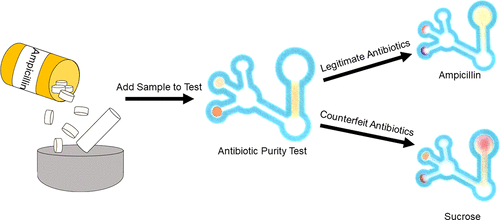Our official English website, www.x-mol.net, welcomes your feedback! (Note: you will need to create a separate account there.)
Paper-Based Enzyme Competition Assay for Detecting Falsified β-Lactam Antibiotics
ACS Sensors ( IF 8.9 ) Pub Date : 2018-06-26 00:00:00 , DOI: 10.1021/acssensors.8b00163 Katherine E. Boehle , Cody S. Carrell , Joseph Caraway , Charles S. Henry
ACS Sensors ( IF 8.9 ) Pub Date : 2018-06-26 00:00:00 , DOI: 10.1021/acssensors.8b00163 Katherine E. Boehle , Cody S. Carrell , Joseph Caraway , Charles S. Henry

|
Falsified and substandard antibiotics are a growing worldwide problem that leads to increased patient mortality and decreased trust in healthcare, and contributes to antimicrobial resistance. Monitoring falsified antibiotics is difficult because most falsified pharmaceuticals are most commonly found in developing countries, where detecting the active ingredient is difficult due to lack of access to complex instrumentation. Herein, we describe the development and optimization of a microfluidic paper-based analytical device (μPAD) to detect the active ingredient in the most falsified class of antibiotics, β-lactams. The assay is based on enzyme competition, making it the first demonstrated competitive enzyme assay reported in paper-based devices. The assay uses nitrocefin, a chromogenic substrate, to compete with β-lactam antibiotics in a reaction with β-lactamase. A yellow color indicates legitimate drugs, while a color change from yellow to red indicates falsified drugs. In addition to testing for the active ingredient, another section of the device was added to test the sample pH to further verify results and identify common falsified ingredients like aspirin or baking soda. Calibration curves for four different antibiotics, including cefazolin, have been generated making it the first paper-based device capable of detecting both cephalosporin and penicillin antibiotics. The μPAD has also been tested with common falsified ingredients and four antibiotics in tablet or injectable form, demonstrating its potential for in-field falsified antibiotic testing.
更新日期:2018-06-26



























 京公网安备 11010802027423号
京公网安备 11010802027423号